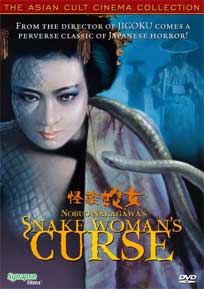 SNAKE
WOMAN’S CURSE (1968)
SNAKE
WOMAN’S CURSE (1968) Director: Nobuo Nakagawa
Synapse Films
 SNAKE
WOMAN’S CURSE (1968)
SNAKE
WOMAN’S CURSE (1968) It was only
a couple of years ago that U.S. soil was inundated with J-Horror remakes. Theaters
were flooded with films like THE GRUDGE, DARK WATER and THE RING, leading most
Americans to believe that all Japanese ghost stories involved creepy teenage
girls with long black hair extensions. Sadly, more traditional Japanese ghost
stories (or Kaidan) are not as well known or as popular as their modern counterparts.
This is a sad state of affairs, as most Kaidan are based on Japanese folklore
or Buddhist stories that are brimming with interesting characters, tense atmosphere
and karmic revenge. Traditional Kaidan pictures often portray how a guilty conscience
can be far more terrifying that a little pale Asian kid who wears too much eye
liner and screams like a cat in heat. 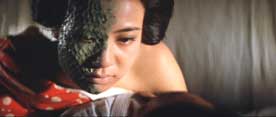
Yasuke is a peasant farmer whose field is reposed by his overbearing landlord,
Chobei Onuma. With no land to tend, Yasuke quickly becomes ill and dies, leaving
behind his wife, Sue, and daughter, Asa. While paying his respects, Chobei informs
the two women that they will return with him to his home, where they will work
to pay off the debt left by Yasuke. Upon leaving the grieving family, Chobei
is suddenly, albeit briefly, confronted by the ghost of Yasuke. Chobei quickly
vacates the village home and orders that it be demolished. Several of the male
villagers are then gathered to destroy the home, which uncovers a serpent that
is quickly killed. Such an act, in feudal Japan, is considered bad luck and
brings with it a curse. Upon reaching the Onuma family home, Asa and Sue are
thrown directly into their duties, where they are worked hard and harassed repeatedly
by Chobei's wife, Masae, and son, Takeo. While tending the family court, Sue
is witness to the beating of another snake found within the home. She throws
herself in harms way too protect the creature, only to be injured herself. This
injury leads to her death and Asa being left alone to fend off the unwanted
advances of Takeo and to pay off her family debt solo. All the while Chobei
and his wife are planning the marriage of their son to the mayor's daughter,
but the curse put forth on the Onuma family threatens to ruin their plans for
a prosperous union.
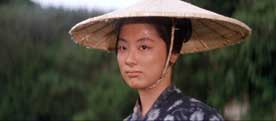 Nobuo
Nakagawa, most often associated with Japanese horror and ghost films, weaves
a tense yet traditional ghost story with SNAKE WOMAN'S CURSE. Those only familiar
with Nakagawa's JIGOKU (released last year through The Criterion Collection),
often cited as his masterpiece, may be a little surprised and possibly even
disappointed, as he takes a much more subdued approach with many of SNAKE WOMAN'S
visuals. That is not to say that there are not several scenes that border on
grotesque, but other than the beating of several snakes, the majority of violence
portrayed is done so off screen. One particular effective scene involves Asa
as she fends off the unwanted advances of Takeo. Having been tricked into isolating
herself on a country road, Takeo chases her like a cat playing with a mouse.
Only for the chase to end as Takeo throws her in the bushes, to take advantage
of her, hidden just out of sight. The scene is then followed by one of Asa left
outside, for dead, where a lighting bolt splits a tree next to her collapsed
body. As if her anger had collected and poured down from the heavens. The tree,
split in half, then reveals a snake.
Nobuo
Nakagawa, most often associated with Japanese horror and ghost films, weaves
a tense yet traditional ghost story with SNAKE WOMAN'S CURSE. Those only familiar
with Nakagawa's JIGOKU (released last year through The Criterion Collection),
often cited as his masterpiece, may be a little surprised and possibly even
disappointed, as he takes a much more subdued approach with many of SNAKE WOMAN'S
visuals. That is not to say that there are not several scenes that border on
grotesque, but other than the beating of several snakes, the majority of violence
portrayed is done so off screen. One particular effective scene involves Asa
as she fends off the unwanted advances of Takeo. Having been tricked into isolating
herself on a country road, Takeo chases her like a cat playing with a mouse.
Only for the chase to end as Takeo throws her in the bushes, to take advantage
of her, hidden just out of sight. The scene is then followed by one of Asa left
outside, for dead, where a lighting bolt splits a tree next to her collapsed
body. As if her anger had collected and poured down from the heavens. The tree,
split in half, then reveals a snake.
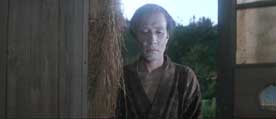
The ghost themselves haunt their victims merely by being in their presence.
They never have any direct contact with the Onuma family. Instead they simply
let it be know that they are still around, letting the guilt boil within, to
the point of madness. This is in striking contrast to more recent J-Horror ghost
films, in which spirits present themselves by crab walking down a flight of
stair as if they are auditioning for Cirque du Soleil.
 Originally
SNAKE WOMAN’S CURSE was scheduled to be released through Panik House Entertainment
in partnership with Synapse Films, along with seven other films from Toei studios.
Synapse has since stepped to the forefront of these releases, presenting them
with the respect and quality that cult film fans have come to expect from Don
May Jr. and Jerry Chandler. SNAKE WOMAN’S CURSE is presented with a new,
fully restored, anamorphic widescreen transfer which maintains the films original
2.35:1 aspect ratio. Having been transferred in high-definition from Toei's
original vault elements, SNAKE WOMAN’S CURSE DVD debut is virtually flawless.
Colors are bright and clear, with only the crashing waves of the Toei logo having
any visible darkening or grain. The Japanese language audio, presented in Dolby
Digital mono 2.0, comes across clear with both the dialogue and soundtrack easy
to follow and enjoy. English subtitles are legible and flow naturally.
Originally
SNAKE WOMAN’S CURSE was scheduled to be released through Panik House Entertainment
in partnership with Synapse Films, along with seven other films from Toei studios.
Synapse has since stepped to the forefront of these releases, presenting them
with the respect and quality that cult film fans have come to expect from Don
May Jr. and Jerry Chandler. SNAKE WOMAN’S CURSE is presented with a new,
fully restored, anamorphic widescreen transfer which maintains the films original
2.35:1 aspect ratio. Having been transferred in high-definition from Toei's
original vault elements, SNAKE WOMAN’S CURSE DVD debut is virtually flawless.
Colors are bright and clear, with only the crashing waves of the Toei logo having
any visible darkening or grain. The Japanese language audio, presented in Dolby
Digital mono 2.0, comes across clear with both the dialogue and soundtrack easy
to follow and enjoy. English subtitles are legible and flow naturally.
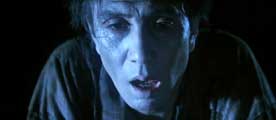
An audio commentary from Japanese film scholar Jonathan M. Hall does a nice
job of exploring particular meanings of certain images and characters as they
pertain to Japanese culture and the social classes of the time in which the
film is set. Although his monotone voice is a bit like listening to Ambien,
he might put you to sleep. A biography of Nobuo Nakagawa and detailed liner
notes by Japanese film scholar Alexander Jacoby do an excellent job of covering
the history of Nakagawa's introduction to the Asian film industry and his collective
works. Original Japanese theatrical trailer and Nakagawa poster gallery round
out the extra features. The DVD cover itself is reversible, with a striking
illustrative cover by Wes Benscoter on one side and the original Japanese poster
on the other. (Jason McElreath)